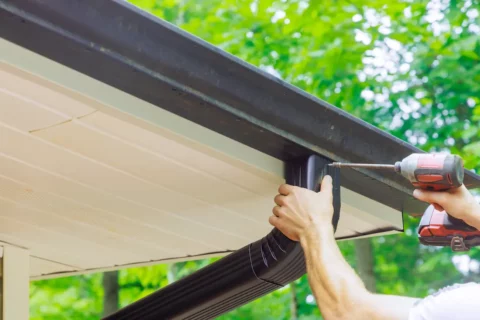Your home is not just a place of comfort; it’s a significant investment that requires diligent care and maintenance. Of all the components that protect your home, the roof plays a crucial role. However, hail damage can have a detrimental impact on your roof, leading to long-term consequences that compromise its integrity and lifespan. In this comprehensive guide, we will explore the long-term effects of roof hail damage, understand its causes, identify signs of damage, and discuss proactive measures to protect your investment.
Understanding Roof Hail Damage
Roof hail damage occurs when hailstones, varying in size and hardness, pummel the surface of your roof. The impact can cause both visible and hidden damage that poses a threat to the roof’s structure and materials. Understanding how hail damage occurs is crucial to taking appropriate steps to minimize its impact on your roof.
Hail damage can occur due to various factors, including wind speed, the size and density of hailstones, and the condition of your roofing materials. Severe hailstorms can cause shingles to crack or break, tiles to become dislodged, and granules to loosen or detach. These visible signs often indicate the immediate effects of hail damage.
The Long-Term Effects of Roof Hail Damage
While immediate signs of hail damage are noticeable, it is essential to recognize the potential long-term consequences. Over time, hail damage can lead to significant problems that compromise the structural integrity of your roof and affect its longevity.
- Roof Lifespan Reduction
Hail damage weakens the protective layers of your roof, reducing its lifespan. The compromised structural integrity makes the roof more susceptible to further damage from future hailstorms, increasing the risk of leaks, water infiltration, and subsequent structural issues. - Weakening of Roof Materials
Hail damage can weaken the roof’s materials, including shingles, tiles, or other roofing components. This weakening can make them more prone to cracks, breaks, or dislodgment even from minor weather events. Weakened materials contribute to the overall deterioration of the roof and make it less capable of withstanding future hailstorms. - Water Infiltration and Structural Concerns
One of the most significant long-term effects of hail damage is water infiltration. Even small cracks or damaged areas can allow water to seep into the roof structure. Over time, this can lead to rot, decay, and compromised structural integrity. Water infiltration can affect not only the roof but also the walls, ceilings, and other parts of your home’s structure. - Mold Growth and Health Hazards
Water infiltration resulting from hail damage creates a favorable environment for mold growth. Mold can thrive in moist, dark areas and spread throughout your home, causing health issues for you and your family. It is crucial to address hail damage promptly to prevent mold growth and associated health hazards. - Energy Efficiency Concerns
Hail damage can also impact the energy efficiency of your home. Damaged or compromised roof materials can lead to air leaks and insufficient insulation, causing your heating and cooling systems to work harder. This inefficiency results in increased energy consumption and higher utility bills.
Protecting Your Investment: Mitigating Long-Term Effects
To protect your investment and minimize the long-term effects of roof hail damage, consider implementing the following proactive measures:
- Regular Roof Inspections:
Schedule regular roof inspections, especially after severe weather events, to detect hail damage early on. Perform visual inspections yourself and look for signs such as dented or dislodged shingles, cracked tiles, or granule loss. Consider hiring a professional roofing contractor for a thorough examination, as they have the expertise to identify even hidden damage. - Prompt Repair and Replacement:
Address hail damage promptly to prevent further deterioration and potential structural issues. Replace damaged shingles, tiles, or other roofing components as soon as possible. Prompt repairs help maintain the structural integrity of your roof and minimize the risk of water infiltration and subsequent damage. - Seek Professional Assistance:
While some minor repairs can be done by homeowners, it is advisable to seek professional assistance for assessing and repairing hail damage. Experienced roofing contractors have the knowledge, skills, and specialized equipment to accurately evaluate the extent of damage and execute repairs effectively. They can also provide recommendations on the best course of action and suggest preventive measures. - Explore Insurance Coverage Options:
Review your homeowner’s insurance policy to understand the extent of coverage for hail damage. Some policies may have specific provisions for roof hail damage, while others may require separate coverage. Consult with your insurance provider to ensure you have adequate coverage and understand the claims process in case of future hail damage. - Implement Preventive Measures:
Consider implementing preventive measures to protect your roof from future hail damage. This may include installing impact-resistant roofing materials, such as Class 4 shingles or tiles, that are designed to withstand hailstorms. Additionally, consider adding protective measures like hail guards or screens to reduce the impact of hailstones on your roof.
Understanding the long-term effects of roof hail damage is crucial for protecting your investment and ensuring the durability of your home. By recognizing the signs of hail damage, taking immediate action, and seeking professional assistance, you can mitigate further deterioration and maintain the structural integrity of your roof. Regular inspections, prompt repairs, and exploring insurance coverage options are vital steps in safeguarding your home against the detrimental consequences of hail damage. Remember, taking proactive measures today can save you money and preserve the long-term value of your home.
Take a proactive approach to protect your investment and secure the longevity of your roof. Assess your roof for hail damage, especially after severe weather events. If you suspect damage or notice visible signs, schedule a professional inspection without delay. Promptly address any damage to prevent further deterioration and potential structural issues. Consult 303 Roofer, a reputable roofing professional who can provide expert advice, reliable repairs, and assistance with insurance claims. By taking immediate action and protecting your investment, you can ensure a safe and resilient home for years to come.




